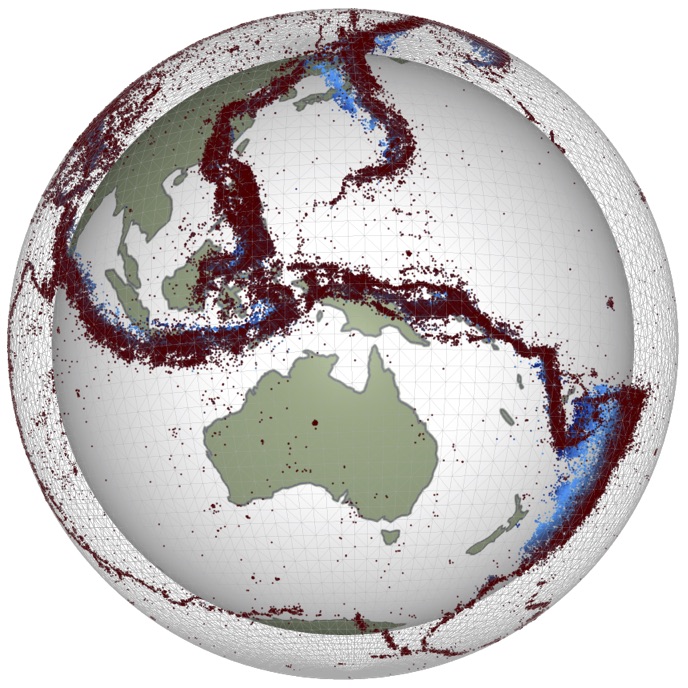Non-linear viscosity convection, Cartesian domain (benchmark)#
This is a convection example with a yield stress but no strain softening. This can be one of the more challenging problems from a solver point of view because the structure of the non-linear response does not get locked into the solution by localisation.
This example demonstrates that the sympy.Piecewise description of the viscosity upon yielding is differentiable and can be used to construct Jacobians.
# to fix trame issue
import nest_asyncio
nest_asyncio.apply()
import petsc4py
from petsc4py import PETSc
import underworld3 as uw
from underworld3.systems import Stokes
from underworld3 import function
import numpy as np
import sympy
meshbox = uw.meshing.UnstructuredSimplexBox(
minCoords=(0.0, 0.0), maxCoords=(1.0, 1.0), cellSize=1.0 / 24.0, qdegree=3
)
v_soln = uw.discretisation.MeshVariable("U", meshbox, meshbox.dim, degree=2)
p_soln = uw.discretisation.MeshVariable("P", meshbox, 1, degree=1)
t_soln = uw.discretisation.MeshVariable("T", meshbox, 1, degree=3)
t_0 = uw.discretisation.MeshVariable("T0", meshbox, 1, degree=3)
visc = uw.discretisation.MeshVariable(r"\eta(\dot\varepsilon)", meshbox, 1, degree=2)
tau_inv = uw.discretisation.MeshVariable(r"|\tau|", meshbox, 1, degree=2)
# Create Stokes object
stokes = Stokes(
meshbox,
velocityField=v_soln,
pressureField=p_soln,
solver_name="stokes",
)
# Set solve options here (or remove default values
# stokes.petsc_options.getAll()
# stokes.petsc_options.delValue("ksp_monitor")
stokes.petsc_options["ksp_monitor"] = None
# Linear visc
delta_eta = 1.0e6
viscosity_L = delta_eta * sympy.exp(-sympy.log(delta_eta) * t_soln.sym[0])
stokes.constitutive_model = uw.constitutive_models.ViscousFlowModel
stokes.constitutive_model.Parameters.viscosity = viscosity_L
stokes.saddle_preconditioner = 1 / viscosity_L
stokes.penalty = 0.0
# Velocity boundary conditions
stokes.add_dirichlet_bc((0.0,), "Left", (0,))
stokes.add_dirichlet_bc((0.0,), "Right", (0,))
stokes.add_dirichlet_bc((0.0,), "Top", (1,))
stokes.add_dirichlet_bc((0.0,), "Bottom", (1,))
# Create a density structure / buoyancy force
# gravity will vary linearly from zero at the centre
# of the sphere to (say) 1 at the surface
import sympy
# Some useful coordinate stuff
x, y = meshbox.X
# Create adv_diff object
# Set some things
k = 1.0
h = 0.0
adv_diff = uw.systems.AdvDiffusion(
meshbox,
u_Field=t_soln,
V_fn=v_soln,
solver_name="adv_diff",
)
adv_diff.constitutive_model = uw.constitutive_models.DiffusionModel
adv_diff.constitutive_model.Parameters.diffusivity = k
adv_diff.theta = 0.5
# Create scalar function evaluators that we can use to obtain viscosity / stress
viscosity_evaluation = uw.systems.Projection(meshbox, visc)
viscosity_evaluation.uw_function = 0.1 + 10.0 / (
1.0 + stokes.Unknowns.Einv2
) # stokes.constitutive_model.material_properties.viscosity
viscosity_evaluation.smoothing = 1.0e-3
#
stress_inv_evaluation = uw.systems.Projection(meshbox, tau_inv)
stress_inv_evaluation.uw_function = (
2.0 * stokes.constitutive_model.Parameters.viscosity * stokes.Unknowns.Einv2
)
stress_inv_evaluation.smoothing = 1.0e-3
expt_name = "output/Ra1e6_TauY"
Rayleigh = 1.0e6
buoyancy_force = Rayleigh * t_soln.sym[0]
stokes.bodyforce = sympy.Matrix([0, buoyancy_force])
# Define T boundary conditions via a sympy function
import sympy
init_t = 0.9 * (0.05 * sympy.cos(sympy.pi * x) + sympy.cos(0.5 * np.pi * y)) + 0.05
adv_diff.add_dirichlet_bc(1.0, "Bottom")
adv_diff.add_dirichlet_bc(0.0, "Top")
with meshbox.access(t_0, t_soln):
t_0.data[...] = uw.function.evaluate(init_t, t_0.coords).reshape(-1, 1)
t_soln.data[...] = t_0.data[...]
# Linear problem for initial solution of velocity field
stokes.solve()
# Now make the viscosity non-linear
tau_Y = 1.0e5 * (1 + 100 * (1 - y))
viscosity_NL = sympy.Piecewise(
(viscosity_L, 2 * viscosity_L * stokes.Unknowns.Einv2 < tau_Y),
(tau_Y / (2 * stokes.Unknowns.Einv2), True),
)
stokes.constitutive_model.Parameters.viscosity = viscosity_NL
stokes.saddle_preconditioner = 1 / viscosity_NL
stokes.solve(zero_init_guess=False)
# Check the diffusion part of the solve converges
adv_diff.solve(timestep=0.01 * stokes.estimate_dt())
# Compute viscosity field
viscosity_evaluation.solve()
stress_inv_evaluation.solve()
with meshbox.access():
print(visc.min(), visc.max())
print(tau_inv.min(), tau_inv.max())
if uw.mpi.size == 1:
import pyvista as pv
import underworld3.visualisation as vis
pvmesh = vis.mesh_to_pv_mesh(meshbox)
pvmesh.point_data["V"] = 1.0 * vis.vector_fn_to_pv_points(pvmesh, v_soln.sym) / vis.vector_fn_to_pv_points(pvmesh, v_soln.sym).max()
pvmesh.point_data["T"] = vis.scalar_fn_to_pv_points(pvmesh, t_soln.sym)
pvmesh.point_data["eta"] = vis.scalar_fn_to_pv_points(pvmesh, visc.sym)
pvmesh.point_data["tau"] = vis.scalar_fn_to_pv_points(pvmesh, tau_inv.sym)
# point sources at cell centres
subsample = 10
cpoints = np.zeros((meshbox._centroids[::subsample].shape[0], 3))
cpoints[:, 0] = meshbox._centroids[::subsample, 0]
cpoints[:, 1] = meshbox._centroids[::subsample, 1]
cpoint_cloud = pv.PolyData(cpoints)
pvstream = pvmesh.streamlines_from_source(
cpoint_cloud,
vectors="V",
integrator_type=45,
integration_direction="forward",
compute_vorticity=False,
max_steps=25,
surface_streamlines=True,
)
points = vis.meshVariable_to_pv_cloud(t_soln)
points.point_data["T"] = vis.scalar_fn_to_pv_points(points, t_soln.sym)
point_cloud = pv.PolyData(points)
## PLOTTING
pl = pv.Plotter(window_size=(750, 750))
pl.add_mesh(
pvmesh,
cmap="coolwarm",
edge_color="Gray",
show_edges=False,
scalars="T",
use_transparency=False,
opacity=0.75,
)
pl.add_mesh(
pvmesh,
cmap="Greys",
show_edges=False,
scalars="eta",
use_transparency=False,
opacity="geom",
)
# pl.add_points(point_cloud, cmap="coolwarm", render_points_as_spheres=False, point_size=10, opacity=0.5)
pl.add_mesh(pvstream, opacity=0.2)
# pl.screenshot(filename="{}.png".format(filename), window_size=(1280, 1280), return_img=False)
pl.show()
def plot_T_mesh(filename):
if uw.mpi.size == 1:
import pyvista as pv
import underworld3.visualisation as vis
pvmesh = vis.mesh_to_pv_mesh(meshbox)
pvmesh.point_data["V"] = 10.0 * vis.vector_fn_to_pv_points(pvmesh, v_soln.sym) / vis.vector_fn_to_pv_points(pvmesh, v_soln.sym).max()
pvmesh.point_data["T"] = vis.scalar_fn_to_pv_points(pvmesh, t_soln.sym)
pvmesh.point_data["eta"] = vis.scalar_fn_to_pv_points(pvmesh, visc.sym)
pvmesh.point_data["tau"] = vis.scalar_fn_to_pv_points(pvmesh, tau_inv.sym)
# point sources at cell centres
subsample = 10
cpoints = np.zeros((meshbox._centroids[::subsample].shape[0], 3))
cpoints[:, 0] = meshbox._centroids[::subsample, 0]
cpoints[:, 1] = meshbox._centroids[::subsample, 1]
cpoint_cloud = pv.PolyData(cpoints)
pvstream = pvmesh.streamlines_from_source(
cpoint_cloud,
vectors="V",
integrator_type=45,
integration_direction="forward",
compute_vorticity=False,
max_steps=25,
surface_streamlines=True,
)
points = vis.meshVariable_to_pv_cloud(t_soln)
points.point_data["T"] = vis.scalar_fn_to_pv_points(points, t_soln.sym)
point_cloud = pv.PolyData(points)
## PLOTTING
pl = pv.Plotter(window_size=(750, 750))
pl.add_mesh(
pvmesh,
cmap="coolwarm",
edge_color="Gray",
show_edges=True,
scalars="T",
use_transparency=False,
opacity=0.75,
)
pl.add_mesh(
pvmesh,
cmap="Greys",
show_edges=False,
scalars="eta",
use_transparency=False,
opacity="geom",
)
pl.add_mesh(pvstream, opacity=0.5)
for key in pvmesh.point_data.keys():
try:
pl.remove_scalar_bar(key)
except KeyError:
pass
pl.screenshot(
filename="{}.png".format(filename),
window_size=(1280, 1280),
return_img=False,
)
# Convection model / update in time
for step in range(0, 250):
stokes.solve(zero_init_guess=False)
delta_t = 5.0 * stokes.estimate_dt()
adv_diff.solve(timestep=delta_t, zero_init_guess=False)
# stats then loop
tstats = t_soln.stats()
if uw.mpi.rank == 0:
print("Timestep {}, dt {}".format(step, delta_t))
plot_T_mesh(filename="{}_step_{}".format(expt_name, step))
# savefile = "{}_ts_{}.h5".format(expt_name,step)
# meshbox.save(savefile)
# v_soln.save(savefile)
# t_soln.save(savefile)
# meshbox.generate_xdmf(savefile)
pass
savefile = “output_conv/convection_cylinder.h5”.format(step) meshbox.save(savefile) v_soln.save(savefile) t_soln.save(savefile) meshbox.generate_xdmf(savefile)
if uw.mpi.size == 1:
import pyvista as pv
import underworld3.visualisation as vis
pvmesh = vis.mesh_to_pv_mesh(meshbox)
pvmesh.point_data["T"] = vis.scalar_fn_to_pv_points(pvmesh, t_soln.sym)
velocity_points = vis.meshVariable_to_pv_cloud(stokes.u)
velocity_points.point_data["V"] = vis.vector_fn_to_pv_points(velocity_points, stokes.u.sym)
points = vis.meshVariable_to_pv_cloud(t_soln)
points.point_data["T"] = vis.scalar_fn_to_pv_points(points, t_soln.sym)
point_cloud = pv.PolyData(points)
points = np.zeros((t_soln.coords.shape[0], 3))
points[:, 0] = t_soln.coords[:, 0]
points[:, 1] = t_soln.coords[:, 1]
pl = pv.Plotter(window_size=(750, 750))
pl.add_arrows(velocity_points.points, velocity_points.point_data["V"], mag=0.00002, opacity=0.75)
# pl.add_arrows(arrow_loc2, arrow_length2, mag=1.0e-1)
pl.add_points(
point_cloud,
cmap="coolwarm",
render_points_as_spheres=True,
point_size=7.5,
opacity=0.25,
)
pl.add_mesh(pvmesh, "Black", "wireframe", opacity=0.75)
pl.show(cpos="xy")
